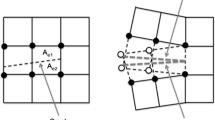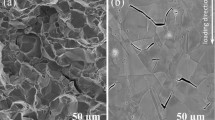Abstract
The competition between intergranular (IG) and transgranular (TG) fracture in fcc polycrystalline aggregates with physically representative GB misorientation distributions comprised of random low-angle, random high-angle, and coincident site lattice (CSL) GBs has been investigated. Physically-based critical conditions for IG fracture, due to the formation of dislocation pileups, and TG fracture, due to the propagation of cracks on cleavage planes, were coupled to a dislocation-density-based crystal plasticity formulation and a computational fracture scheme for crack branching to investigate how dislocation–GB interactions influence dislocation transmission, pileup formation, and local failure modes. The predictions indicate that aggregates with a large fraction of random and CSL high-angle GBs are dominated by IG fracture, as low GB transmission leads to extensive dislocation-density pileup formation and localized stress accumulations that induce IG fracture. Aggregates with a majority of low-angle GBs are dominated by TG failure, which is consistent with experimental observations. This investigation provides a fundamental understanding of the physical mechanisms governing IG and TG fracture in polycrystalline aggregates.












Similar content being viewed by others
References
Watanabe T (2011) Grain boundary engineering: historical perspective and future prospects. J Mater Sci 46:4095–4115. https://doi.org/10.1007/s10853-011-5393-z
Lee TC, Robertson IM, Birnbaum HK (1989) Prediction of slip transfer mechanisms across grain boundaries. Scr Metall 23:799–803. https://doi.org/10.1016/0036-9748(89)90534-6
Su J-Q, Demura M, Hirano T (2003) Mechanical behaviour of Σ3 boundaries in Ni3Al. Acta Mater 51:2505–2515. https://doi.org/10.1016/S1359-6454(03)00047-8
Zaefferer S, Kuo J-C, Zhao Z et al (2003) On the influence of the grain boundary misorientation on the plastic deformation of aluminum bicrystals. Acta Mater 51:4719–4735. https://doi.org/10.1016/S1359-6454(03)00259-3
Kim T, Hong KT, Lee KS (2003) The relationship between the fracture toughness and grain boundary character distribution in polycrystalline NiAl. Intermetallics 11:33–39. https://doi.org/10.1016/S0966-9795(02)00167-X
Zhang ZF, Eckert ZGW (2003) What types of grain boundaries can be passed through by persistent slip bands? J Mater Res 18:1031–1034
Robertson IM, Lee TC, Birnbaum HK (1992) Application of the in situ TEM deformation technique to observe how “clean” and doped grain boundaries respond to local stress concentrations. Ultramicroscopy 40:330–338. https://doi.org/10.1016/0304-3991(92)90130-C
Miyamoto H, Koga H, Mimaki T, Hashimoto S (2001) Intergranular stress corrosion cracking of pure copper \( \langle 111\rangle \) tilt bicrystals. Interface Sci 9:281–286. https://doi.org/10.1023/A:1015167030009
Wang J-S, Anderson PM (1991) Fracture behavior of embrittled F.C.C. metal bicrystals. Acta Metall Mater 39:779–792. https://doi.org/10.1016/0956-7151(91)90278-9
Suzuki A, Gigliotti MFX, Subramanian PR (2011) Novel technique for evaluating grain boundary fracture strength in metallic materials. Scr Mater 64:1063–1066. https://doi.org/10.1016/j.scriptamat.2011.02.024
Jin YJ, Lu H, Yu C, Xu JJ (2013) Study on grain boundary character and strain distribution of intergranular cracking in the CGHAZ of T23 steel. Mater Charact 84:216–224. https://doi.org/10.1016/j.matchar.2013.08.004
Lee TC, Robertson IM, Birnbaum HK (1992) Interaction of dislocations with grain boundaries in Ni3Al. Acta Metall Mater 40:2569–2579. https://doi.org/10.1016/0956-7151(92)90326-A
Wu Q, Zikry MA (2016) Microstructural modeling of transgranular and intergranular fracture in crystalline materials with coincident site lattice grain-boundaries: σ3 and σ17b bicrystals. Mater Sci Eng A. https://doi.org/10.1016/j.msea.2016.02.039
Kobayashi S, Tsurekawa S, Watanabe T (2006) Structure-dependent triple junction hardening and intergranular fracture in molybdenum. Philos Mag 86:5419–5429
Watanabe T, Tsurekawa S (2004) Toughening of brittle materials by grain boundary engineering. Mater Sci Eng A 387:447–455. https://doi.org/10.1016/j.msea.2004.01.140
Randle V, Coleman M (2009) A study of low-strain and medium-strain grain boundary engineering. Acta Mater 57:3410–3421. https://doi.org/10.1016/j.actamat.2009.04.002
Pan Y, Adams BL, Olson T, Panayotou N (1996) Grain-boundary structure effects on intergranular stress corrosion cracking of alloy X-750. Acta Mater 44:4685–4695. https://doi.org/10.1016/S1359-6454(96)00125-5
Bechtle S, Kumar M, Somerday BP et al (2009) Grain-boundary engineering markedly reduces susceptibility to intergranular hydrogen embrittlement in metallic materials. Acta Mater 57:4148–4157. https://doi.org/10.1016/j.actamat.2009.05.012
Gertsman VY, Bruemmer SM (2001) Study of grain boundary character along intergranular stress corrosion crack paths in austenitic alloys. Acta Mater 49:1589–1598. https://doi.org/10.1016/S1359-6454(01)00064-7
Ohfuji T, Suzuki S, Takaki S, Kimura H (1992) Low temperature fracture of high purity iron and its relationship to the grain boundary character. Mater Trans JIM 33:138–142
Watanabe T, Tsurekawa S (1999) The control of brittleness and development of desirable mechanical properties in polycrystalline systems by grain boundary engineering. Acta Mater 47:4171–4185. https://doi.org/10.1016/S1359-6454(99)00275-X
Lin P, Palumbo G, Erb U, Aust KT (1995) Influence of grain boundary character distribution on sensitization and intergranular corrosion of alloy 600. Scr Metall Mater 33:1387–1392. https://doi.org/10.1016/0956-716X(95)00420-Z
Aust KT, Erb U, Palumbo G (1994) Interface control for resistance to intergranular cracking. Mater Sci Eng A 176:329–334. https://doi.org/10.1016/0921-5093(94)90995-4
Palumbo G, Lehockey EM, Lin P, Erb U, Aust K (1996) A grain boundary engineering approach to materials reliability. MRS Proceedings 458:273. https://doi.org/10.1557/PROC-458-273
de Koning M, Kurtz RJ, Bulatov VV et al (2003) Modeling of dislocation–grain boundary interactions in FCC metals. J Nucl Mater 323:281–289. https://doi.org/10.1016/j.jnucmat.2003.08.008
Sangid MD, Ezaz T, Sehitoglu H, Robertson IM (2011) Energy of slip transmission and nucleation at grain boundaries. Acta Mater 59:283–296
Abuzaid WZ, Sangid MD, Carroll JD et al (2012) Slip transfer and plastic strain accumulation across grain boundaries in Hastelloy X. J Mech Phys Solids 60:1201–1220. https://doi.org/10.1016/j.jmps.2012.02.001
Lagow B, Robertson I, Jouiad M et al (2001) Observation of dislocation dynamics in the electron microscope. Mater Sci Eng A 309:445–450. https://doi.org/10.1016/S0921-5093(00)01699-3
Armstrong DEJ, Wilkinson AJ, Roberts SG (2011) Micro-mechanical measurements of fracture toughness of bismuth embrittled copper grain boundaries. Philos Mag Lett 91:394–400. https://doi.org/10.1080/09500839.2011.573813
Gourgues A-F (2002) Electron backscatter diffraction and cracking. Mater Sci Technol 18:119–133
Kacher J, Eftink BP, Cui B, Robertson IM (2014) Dislocation interactions with grain boundaries. Curr Opin Solid State Mater Sci 18:227–243. https://doi.org/10.1016/j.cossms.2014.05.004
Liu GS, House SD, Kacher J et al (2014) Electron tomography of dislocation structures. Mater Charact 87:1–11. https://doi.org/10.1016/j.matchar.2013.09.016
Bond GM, Robertson IM, Birnbaum HK (1987) Effect of boron on the mechanism of strain transfer across grain boundaries in Ni3Al. J Mater Res 2:436–440. https://doi.org/10.1557/JMR.1987.0436
Zikry MA (1994) An accurate and stable algorithm for high strain-rate finite strain plasticity. Comput Struct 50:337–350. https://doi.org/10.1016/0045-7949(94)90004-3
Ziaei S, Zikry MA (2015) Modeling the effects of dislocation–density interaction, generation, and recovery on the behavior of H.C.P materials. Metall Mater Trans A 46:4478–4490. https://doi.org/10.1007/s11661-014-2635-0
Asaro RJ, Rice JR (1977) Strain localization in ductile single crystals. J Mech Phys Solids 25:309–338. https://doi.org/10.1016/0022-5096(77)90001-1
Franciosi P, Berveiller M, Zaoui A (1980) Latent hardening in copper and aluminium single crystals. Acta Metall 28:273–283. https://doi.org/10.1016/0001-6160(80)90162-5
Zikry MA, Kao M (1996) Dislocation based multiple-slip crystalline constitutive formulation for finite-strain plasticity. Scr Mater 34:1115–1121. https://doi.org/10.1016/1359-6462(95)00629-X
Shanthraj P, Zikry MA (2011) Dislocation density evolution and interactions in crystalline materials. Acta Mater 59:7695–7702. https://doi.org/10.1016/j.actamat.2011.08.041
Lim LC, Raj R (1985) Continuity of slip screw and mixed crystal dislocations across bicrystals of nickel at 573 K. Acta Metall 33:1566–1583
Ma A, Roters F, Raabe D (2006) Studying the effect of grain boundaries in dislocation density based crystal-plasticity finite element simulations. Int J Solids Struct 43:7287–7303. https://doi.org/10.1016/j.ijsolstr.2006.07.006
Shantraj P, Zikry MA (2013) Microstructurally induced fracture nucleation and propagation in martensitic steels. J Mech Phys Solids 61:1091–1105
Scardia L, Peerlings RHJ, Peletier MA, Geers MGD (2014) Mechanics of dislocation pile-ups: a unification of scaling regimes. J Mech Phys Solids 70:42–61. https://doi.org/10.1016/j.jmps.2014.04.014
Tesař K, Jäger A (2014) Electron backscatter diffraction analysis of the crack development induced by uniaxial tension in commercially pure titanium. Mater Sci Eng A 616:155–160. https://doi.org/10.1016/j.msea.2014.08.028
Wan VVC, Cuddihy MA, Jiang J et al (2016) An HR-EBSD and computational crystal plasticity investigation of microstructural stress distributions and fatigue hotspots in polycrystalline copper. Acta Mater 115:45–57. https://doi.org/10.1016/j.actamat.2016.05.033
Wu Q, Zikry MA (2014) Microstructural modeling of crack nucleation and propagation in high strength martensitic steels. Int J Solids Struct. https://doi.org/10.1016/j.ijsolstr.2014.08.021
Hansbo A, Hansbo P (2004) A finite element method for the simulation of strong and weak discontinuities in solid mechanics. Comput Methods Appl Mech Eng 193:3523–3540. https://doi.org/10.1016/j.cma.2003.12.041
Rezvanian O, Zikry MA, Rajendran AM (2008) Microstructural modeling in f.c.c. crystalline materials in a unified dislocation-density framework. Mater Sci Eng A 494:80–85
Wo P, Ngan AHW (2004) Investigation of slip transmission behavior across grain boundaries in polycrystalline Ni3Al using nanoindentation. J Mater Res 19:189–201. https://doi.org/10.1557/jmr.2004.19.1.189
Kobayashi S, Maruyama T, Saito S et al (2014) In situ observations of crack propagation and role of grain boundary microstructure in nickel embrittled by sulfur. J Mater Sci 49:4007–4017. https://doi.org/10.1007/s10853-014-8056-z
Lee TC, Robertson IM, Birnbaum HK (1989) An HVEM In situ deformation study of nickel doped with sulfur. Acta Metall 37:407–415. https://doi.org/10.1016/0001-6160(89)90225-3
Watanabe T (1994) The impact of grain boundary character distribution on fracture in polycrystals. Mater Sci Eng A 176:39–49. https://doi.org/10.1016/0921-5093(94)90957-1
Tromans D, Sun RH (1996) Intergranular/transgranular fatigue of copper: influence of environment on crack path and propagation rates. Mater Sci Eng A 219:56–65. https://doi.org/10.1016/S0921-5093(96)10422-6
Patriarca L, Abuzaid W, Sehitoglu H, Maier HJ (2013) Slip transmission in bcc FeCr polycrystal. Mater Sci Eng A 588:308–317. https://doi.org/10.1016/j.msea.2013.08.050
Zhang L, Lu C, Tieu K (2016) A review on atomistic simulation of grain boundary behaviors in face-centered cubic metals. Comput Mater Sci 118:180–191. https://doi.org/10.1016/j.commatsci.2016.03.021
Kumar K, Van Swygenhoven H, Suresh S (2003) Mechanical behavior of nanocrystalline metals and alloys. Acta Mater 51:5743–5774. https://doi.org/10.1016/j.actamat.2003.08.032
Lim LC, Watanabe T (1990) Fracture toughness and brittle-ductile transition controlled by grain boundary character distribution (GBCD) in polycrystals. Acta Metall Mater 38:2507–2516. https://doi.org/10.1016/0956-7151(90)90262-F
Watanabe T, Fujii H, Oikawa H, Arai KI (1989) Grain boundaries in rapidly solidified and annealed Fe-6.5 mass% Si polycrystalline ribbons with high ductility. Acta Metall 37:941–952. https://doi.org/10.1016/0001-6160(89)90021-7
Acknowledgements
Funding was provided by Office of Naval Research (Grant No. N00014-10-1-0958) MURI Program.
Author information
Authors and Affiliations
Corresponding author
Ethics declarations
Conflict of interest
There are no conflicts of interest that exist for the manuscript’s authors that could potentially influence or bias the submitted work.
Rights and permissions
About this article
Cite this article
Bond, D.M., Zikry, M.A. Differentiating between intergranular and transgranular fracture in polycrystalline aggregates. J Mater Sci 53, 5786–5798 (2018). https://doi.org/10.1007/s10853-017-1847-2
Received:
Accepted:
Published:
Issue Date:
DOI: https://doi.org/10.1007/s10853-017-1847-2




